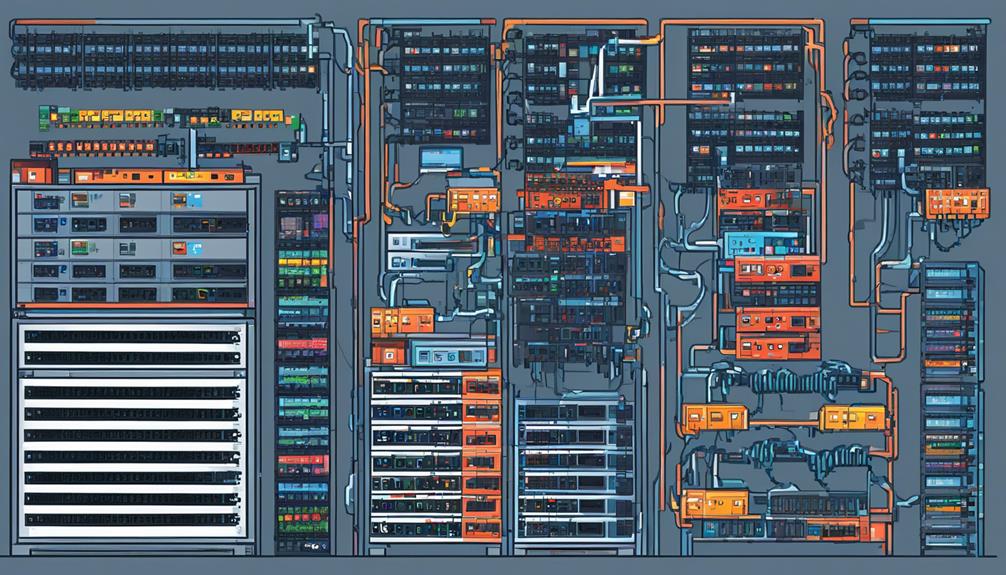As businesses increasingly rely on advanced communication systems, the proper wiring of a PBX (Private Branch Exchange) system becomes crucial. PBX wiring serves as the backbone of the system, connecting various components and ensuring seamless communication within the organization.
From understanding the basics of PBX wiring to troubleshooting common issues, this discussion aims to equip you with the knowledge and insights necessary to wire your PBX system effectively. Whether you are setting up a new system or upgrading an existing one, the information provided here will guide you through the technical intricacies, ensuring reliability and optimal performance.
So, let's dive into the world of PBX wiring and unravel the secrets to building a robust communication infrastructure.
Key Takeaways
- PBX systems use two wires, Tip and Ring, for telephone connections.
- Choose connectors compatible with the wiring and equipment in your PBX system.
- Proper cable management improves efficiency, troubleshooting, and minimizes disruptions.
- Understand the wiring setup in the house and strategically place the PBX for optimized connectivity.
Understanding PBX Wiring Basics

Understanding the fundamental principles of PBX wiring is essential for effectively connecting telephone systems. PBX systems utilize two wires, known as Tip and Ring, for telephone connections. These wires are typically color-coded as green for Tip and red for Ring in modular telephone cables. Different wiring systems, such as Star and Loop, are used to connect modular wall plates to a central location.
A crucial component in PBX wiring is the network interface box, where the phone company's lines enter the house. This box serves as the point of connection between the external telephone line and the internal PBX system. It is responsible for providing power and ensuring the functionality of the telephone system.
Before making any changes to the PBX wiring, it is important to understand the existing setup and create a detailed map. This will help in planning modifications and ensuring a smooth installation process. Additionally, it is crucial to have a clear understanding of the different components involved in PBX wiring, such as the punch-down block. This block acts as a termination point for connecting the telephone lines to the extension lines.
Choosing the Right Connectors for Your PBX
To ensure a seamless and efficient PBX installation, it is imperative to carefully select the appropriate connectors for your system. The connectors play a crucial role in establishing reliable and high-quality connections within your telephone system.
Here are some important factors to consider when choosing connectors for your PBX system:
- Compatibility:
Ensure that the connectors you choose are compatible with the wiring and equipment in your PBX system. Compatibility issues can lead to poor connections and may result in call quality degradation or even system failure.
Select connectors that are compatible with the specific type of wiring used in your PBX system, such as twisted pair or coaxial cables. This will ensure proper signal transmission and minimize interference.
- Durability and Reliability:
Opt for connectors that are durable and designed to withstand the demands of a telephone system environment. PBX systems often experience frequent plugging and unplugging of cables, so it is important to choose connectors that can withstand repeated use without compromising signal quality.
Look for connectors that provide a secure and reliable connection. Connectors with gold-plated contacts offer better conductivity and corrosion resistance, ensuring a stable connection over time.
Proper Cable Management for PBX Wiring

Effective cable management is essential for ensuring the proper organization and functionality of your PBX wiring system. Proper cable management involves the installation and organization of cables within the private branch exchange (PBX) system to optimize communication within your organization.
When installing the PBX phone system, it is crucial to consider the cable management aspect. A well-organized cable infrastructure not only improves the efficiency of your PBX system but also makes troubleshooting and maintenance easier. It minimizes the risk of tangled or damaged cables, which can lead to disruptions in communication.
To achieve proper cable management, it is important to label each cable and document its purpose and destination. This documentation can be useful during installation, upgrades, or troubleshooting processes. Additionally, using color-coded cables can further enhance the organization and identification of different types of connections.
Another aspect of proper cable management is to ensure that the cables are properly secured and protected. This can be achieved by using cable trays, conduit, or cable ties to neatly bundle the cables together. These measures not only prevent cables from becoming tangled but also protect them from accidental damage.
Moreover, organizing the telephone lines using separate conduits or cable trays helps to minimize interference and crosstalk between cables, resulting in improved call quality and reduced signal degradation.
Tips for Wiring Your PBX System for Reliability
When wiring your PBX system for optimal reliability, it is crucial to implement certain techniques and strategies to ensure the efficient functioning of your communication infrastructure. Here are some tips to help you achieve a reliable PBX wiring system:
- Properly solder and seal connections: To enhance reliability, it is essential to ensure that all connections are securely soldered and properly sealed. This will prevent any loose connections or exposure to moisture, which can lead to signal loss or degradation.
- Central placement of the PBX: Positioning the PBX centrally in a star system or in the middle of a loop system can significantly improve connectivity and discrete pair usage. This arrangement allows for efficient distribution of signals to different extensions, reducing the chances of signal loss or interference.
- Plan extensions and make modifications: Careful planning of extensions is crucial for maintaining a reliable PBX system. Identify which jacks will share the same extension number and allocate individual extensions for the remaining jacks. This will help in streamlining communication and ensuring smooth operation of your phone systems.
- Use punch down blocks: Utilizing punch down blocks is an effective way to enhance reliability in your PBX wiring. These blocks provide secure connections and support advanced data management, allowing for efficient transmission of signals and minimizing the risk of connectivity issues.
Following these tips will help you wire your PBX system for optimal reliability. By implementing proper techniques and strategies, you can ensure smooth communication and minimize downtime, enhancing the overall efficiency of your phone systems.
Troubleshooting Common Wiring Issues in PBX Systems

One common issue that may arise when dealing with PBX system wiring is the occurrence of connectivity problems. Troubleshooting these wiring issues is essential to ensure a reliable and efficient telephone network. When facing connectivity problems, it is crucial to check all modular jacks in the house before making any changes or connections to the existing telephone system. Understanding the wiring setup in the house, including the type of system, jacks, and cables present, is also important in troubleshooting these common issues.
To troubleshoot connectivity problems, it is recommended to properly label and connect the wires at the modular jacks. This ensures a neat and organized system, making it easier to identify any potential issues. Additionally, placing the PBX strategically in the center of a star system or the middle of a loop system can help optimize connectivity.
Triple-checking any modifications at the modular jacks before proceeding is another crucial step in troubleshooting common wiring issues. This ensures accurate and efficient wiring connections, reducing the chances of connectivity problems.
Frequently Asked Questions
How Do I Set up My Own Pbx?
Setting up a PBX system can be a daunting task, but with the right knowledge and guidance, it can be a rewarding experience.
To begin, you will need to understand the hardware requirements for your PBX system.
Next, you should research and select the right software that suits your needs.
Configuring and utilizing SIP trunks is another important aspect to consider.
Additionally, implementing essential security measures will ensure the protection of your PBX system.
Lastly, being able to troubleshoot common issues that may arise during the setup and configuration process is crucial.
What Is PBX Wiring?
PBX wiring refers to the installation process of connecting phone lines within a private branch exchange system. It involves various wiring techniques and troubleshooting tips to ensure proper functionality.
Best practices include understanding the existing infrastructure, strategically placing the PBX, and planning modifications and extensions.
The process requires specific equipment requirements, such as PBX connectors and punch down blocks.
Precise and detailed execution of PBX wiring is crucial for establishing and maintaining a reliable telecommunication system.
What Are the Three Main Components of the Pbx?
The three main components of a PBX system are the PBX itself, the telephone sets, and the outside telephone lines.
The PBX acts as the central control unit, managing the incoming and outgoing calls, as well as providing various features like call forwarding, voicemail, and conference calling.
The telephone sets are used by the users to make and receive calls, while the outside telephone lines connect the PBX to the public telephone network.
Setting up a PBX system requires proper wiring and installation, which can vary in cost depending on the complexity of the setup.
However, the benefits of a PBX system include improved communication efficiency, cost savings on long-distance calls, and enhanced call management capabilities.
How Much Does It Cost to Install a PBX System?
The cost of installing a PBX system can vary depending on several factors. These include:
- The size and complexity of the system
- The number of phone lines
- The type of PBX system
- Any additional hardware or equipment needed
It is important to carefully consider these factors and obtain quotes from multiple vendors to ensure a comprehensive understanding of the investment required.
Additionally, ongoing maintenance, training, support, and potential future upgrades or expansions should also be considered.
Taking these factors into account can help in finding a cost-effective solution for PBX system installation.
